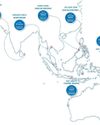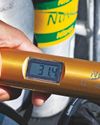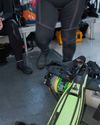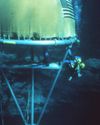“Queen of the Mantas” Andrea Marshall shares powerful insights into the subtle challenges facing women in the sciences.

Gender-related topics almost invariably come up when I talk about my work as a scientist. Conversations that start about my work with manta rays always seem to circle around to probing questions about the challenges of being a female researcher. I find people’s interest in this subject perplexing. Sure, being a field researcher is hard… but what does being a woman have to do with that? I fight the same defensive feeling when I see eyebrows raise upon learning that I am the CEO of an international conservation organisation... like for a moment they find this fact hard to believe. Have we seriously not moved past this?
While this line of questioning can sometimes get a bit tedious, I have started to reconcile myself to the fact that this issue is indeed important and worthy of addressing. The main reason for this conclusion is the hundreds, maybe thousands, of young girls that have contacted me throughout my career looking for advice – girls who see me as a role model, that aspire to have a career like mine, or that want to work in the field like I do; young women of all ages that are looking for recommendations or for advice; ones needing to hear first-hand that they can make it. Sometimes I can tell that they are looking to reassure themselves; others are looking for ways to assuage the fears of their family or friends. Strangely, I never get these kinds of letters/e-mail/questions from boys. Is that because I am not a role model for them, despite being an authority in my field? Or is it rather because they do not have the same reservations that young girls do. Logic tells me it is the latter and I see evidence all the time that young girls are somehow less confident about career paths in science, technology, engineering, mathematics (STEM) fields than young boys.
هذه القصة مأخوذة من طبعة Issue 01-2017 (107) من Scuba Diver.
ابدأ النسخة التجريبية المجانية من Magzter GOLD لمدة 7 أيام للوصول إلى آلاف القصص المتميزة المنسقة وأكثر من 9,000 مجلة وصحيفة.
بالفعل مشترك ? تسجيل الدخول
هذه القصة مأخوذة من طبعة Issue 01-2017 (107) من Scuba Diver.
ابدأ النسخة التجريبية المجانية من Magzter GOLD لمدة 7 أيام للوصول إلى آلاف القصص المتميزة المنسقة وأكثر من 9,000 مجلة وصحيفة.
بالفعل مشترك? تسجيل الدخول

The Making Of A World Record-Breaking Diver
Descending more than 300 metres into the depths of the ocean may sound like a daunting prospect to even the most seasoned diver. But to one man, it was just another a challenge that he set for himself to see how far he was able to push the envelope.

Risk Mitigation: Hose Failure
An unexpected outcome

Top 10 Wrecks Of Asia-Pacific
We present a curated list of the top 10 most famous wrecks found in the Asia-Pacific region, listed in no particular order

From The Medical Line: Diving After DCS
DAN medical information specaialists and researchers answer your dive medicine questions

Cave Exploration: Beginning With The End In Mind
Building complex adventures on simple skills

Dive Slate: Stay Safe On Board
When preparing for a dive, safety is at the top of the list – checking gear, learning potential site hazards and discussing procedures with your divemaster or buddy.

101 Tips On Becoming A Better Tek Diver
Technical diving takes divers beyond the typical recreational scuba diving limits, opening up many new and exciting possibilities.

TECHNICAL DIVING TIMELINE (1660–1999)
It’s fair to say that the emergence of “technical diving” in the late 1980s, that is, the introduction of mixed gas technology, and later mixed gas rebreathers to the sport diving community, represented the culmination of hundreds of years of scientific discovery and technological development.

FLYING AFTER DIVING
From the Safety Stop

DIAGNOSING DECOMPRESSION ILLNESS
Incident Insight